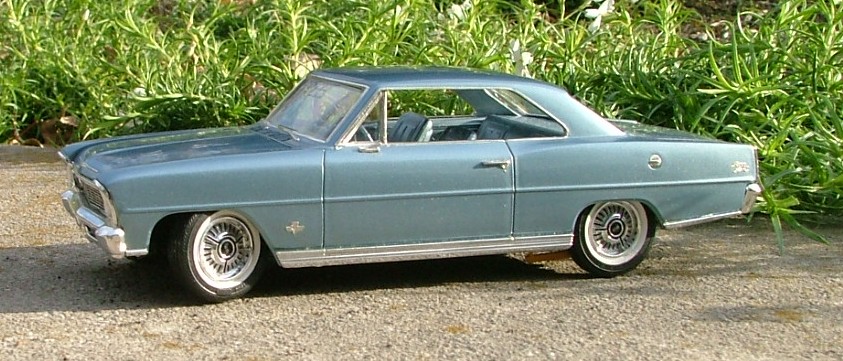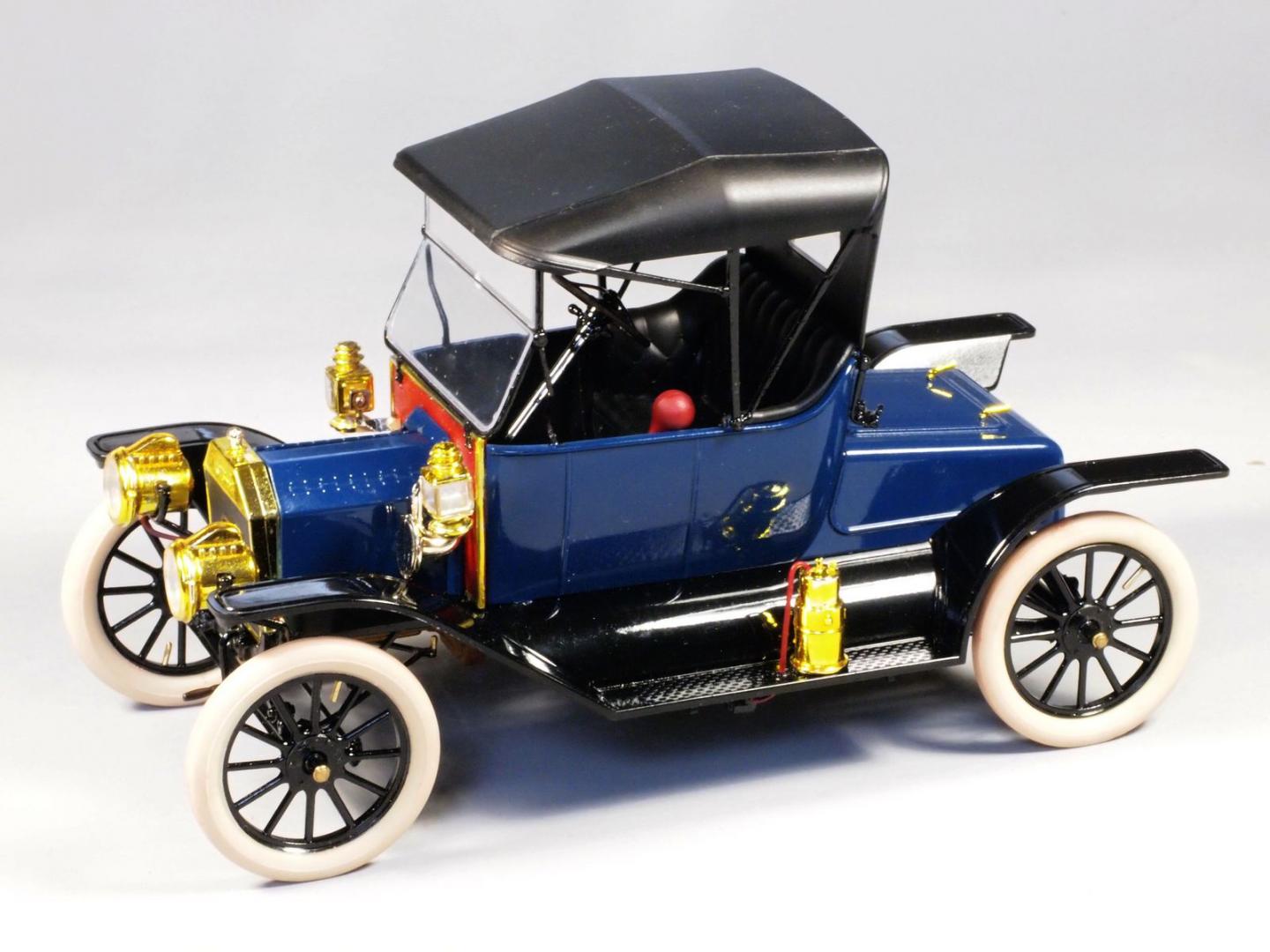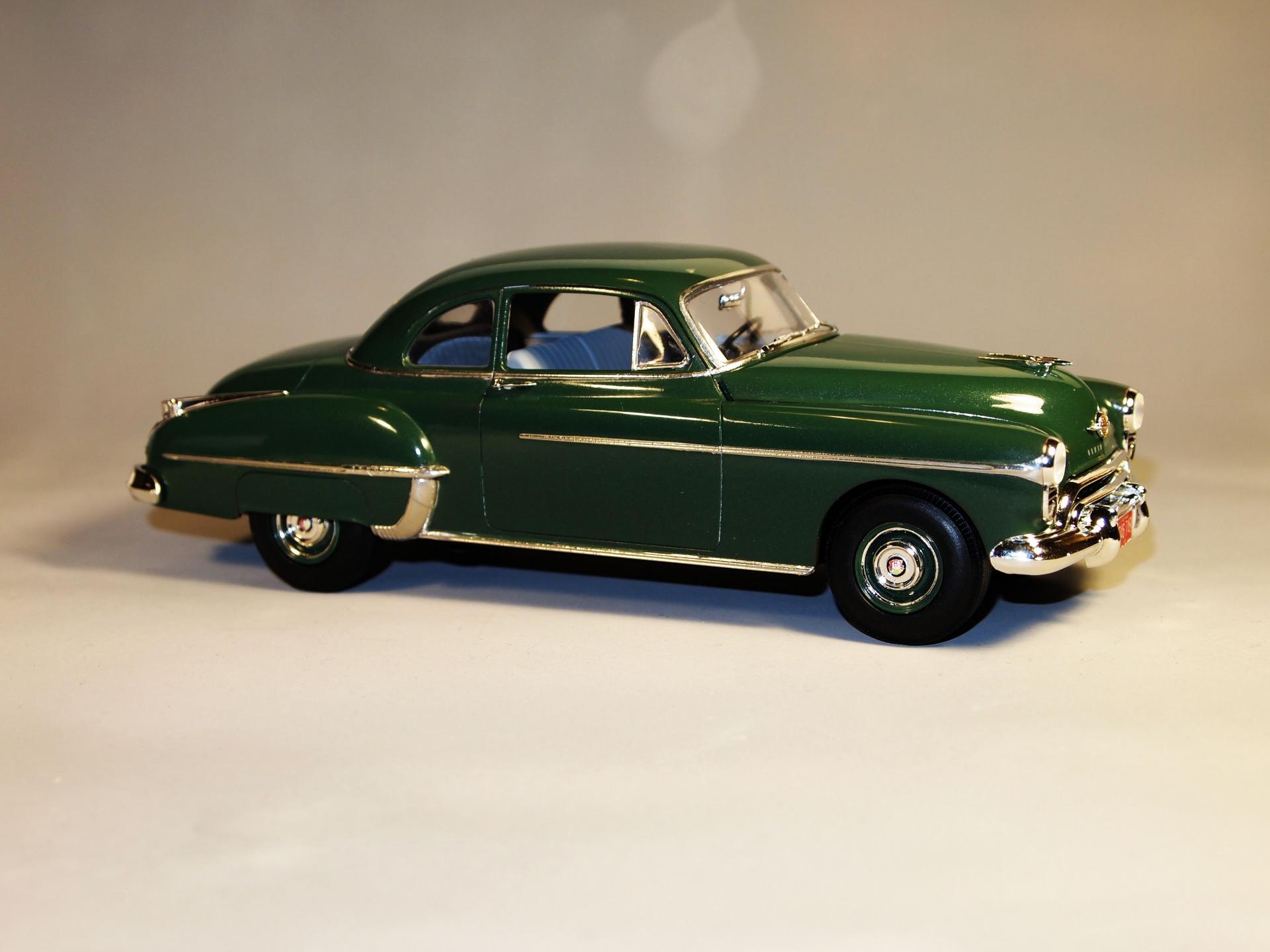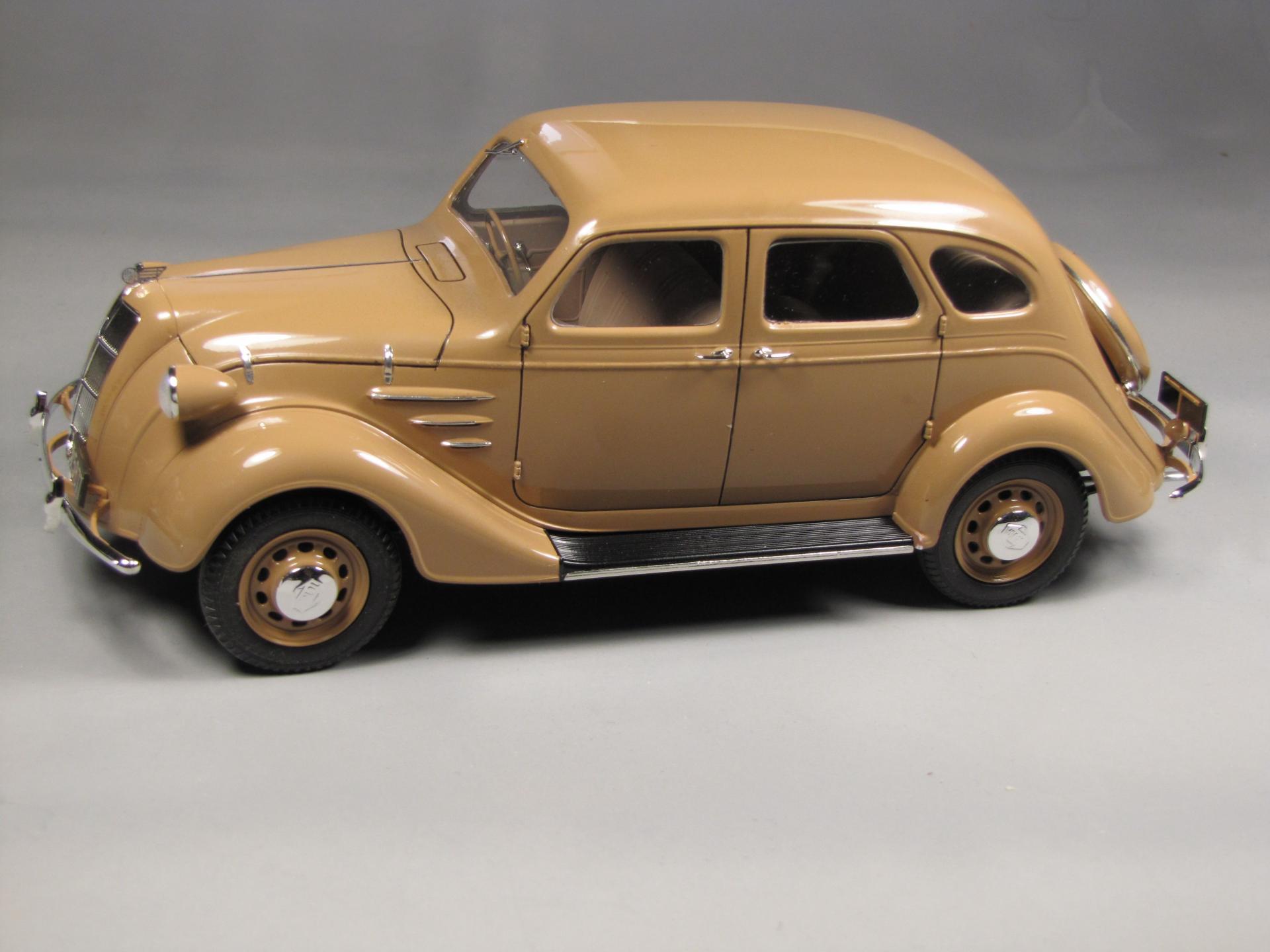
Art Anderson
Members-
Posts
5,052 -
Joined
-
Last visited
Content Type
Profiles
Forums
Events
Gallery
Everything posted by Art Anderson
-
New Tamiya Lacquers for Airbrushing?
Art Anderson replied to Snake45's topic in Car Aftermarket / Resin / 3D Printed
And this one, the then newly released (in the spring of 1967) AMT/Ertl 1966 Chevrolet Nova SS hardtop, painted in Martin Senour factory match acrylic lacquer (Clean Strip was not around yet, so this got Aero-Gloss model airplane dope thinner, from my inventory from my hobby shop, the former Modelmaker, in Lafayette IN: -
New Tamiya Lacquers for Airbrushing?
Art Anderson replied to Snake45's topic in Car Aftermarket / Resin / 3D Printed
Oh and this one, the ICM 1913 Model T Ford Runabout, all bodywork painted with Tamiya lacquers, thinned as described above, with Clean-Strip: -
New Tamiya Lacquers for Airbrushing?
Art Anderson replied to Snake45's topic in Car Aftermarket / Resin / 3D Printed
A couple of examples from recent years: Revell '50 Olds 88 coupe, and the Tamiya '36 Toyoda AA Sedan. The Olds was shot in Scale Finishes factory match acrylic enamel, the Toyoda in Testors bottle paints--home mix for a close match to pics online: Both were thinned as I described above: Hopefully, Moebius will consider using a larger box so everything is not jammed in there. The two F100 kits I have ('71 Ranger and '72 Sport Custom) have warped cabs that I'm trying to straighten out because they were jammed into the box before the plastic had cooled from the molding process. -
New Tamiya Lacquers for Airbrushing?
Art Anderson replied to Snake45's topic in Car Aftermarket / Resin / 3D Printed
Oh, and Pete, I have dozens of cans of automotive lacquers, some dating back to the early post-WW-II years, along with automotive enamels from the same era--I've used many of those in years past, gotten the same show-stopping results, but sadly those were all on scale models of Indianapolis race cars, and I sold that vast collection, in a weak moment, back in 1965. Art -
New Tamiya Lacquers for Airbrushing?
Art Anderson replied to Snake45's topic in Car Aftermarket / Resin / 3D Printed
Pete, I have no desire to get into any online argument here, but I will say that I've been thinning paint, from nitrocellulose automotive lacquer, acrylic automotive lacquer, Aero-Gloss model airplane dope, Tamiya and Testors Modelmaster lacquers (Oh, and regular petroleum-based enamels--from professional grade down to the likes of Testors) since my first airbrush, a Binks Wren (bought on the 26th of December 1961 with a mix of paper route money, and Christmas $$ for approximately $90 in 1961 money). I've never had anything but the best of results from that time to now (have a bunch of trophies and plaques to back that up, too). And no, not all lacquer thinners are mostly acetone, although acetone is a part of the blend, for sure. While I have settled on "Klean-Strip" from Walmart, I have also bitten the bullet--used automotive lacquer thinner from Martin-Senour, and DuPont--all have given me the very same results (Oh, I forgot--at the outset, I used Pactra Aero-Gloss Dope thinner too!). Even my technique hasn't changed, in how I thin lacquers (or enamels, for that matter), I thin all such paints to the consistency of skim milk (easy to see, just by observing how the mix "sheets" down the inside surface of my airbrush color jar), and the pressure I used at the airbrush--no pressure regulator, I just start out bleeding the air by my moisture trap petcock, and go from there--it's worked for me since I learned that by doing, now 57 years ago. I may not know what I am doing, but I do know the results, and have many awards to prove it as well. So, I guess I can say, "Been there, done that, got the Tee-Shirt.) Art -
New Tamiya Lacquers for Airbrushing?
Art Anderson replied to Snake45's topic in Car Aftermarket / Resin / 3D Printed
I've always used plain old lacquer thinner (Clean Strip from Walmart) to thin all lacquers AND enamels for airbrushing--very compatible, get great results every time! Art Anderson -
Enamel paint removal query
Art Anderson replied to HotRodaSaurus's topic in Model Building Questions and Answers
The very earlest Monogram plastic kits (they did balsa and white pine kits at their startup) were molded in acetate! Art -
Help,Need Resin Service Station Accessories
Art Anderson replied to Badluck 13's topic in WIP: Dioramas
Sadly, SMBC is no more, the guy behind it passed away almost 2 years ago. -
Ron, I also did up a 1958 Edsel Bermuda off of a Revell '57 Country Squire--it came out as nice, in resin, as did my AAM Country Squire kit.
-
And then there's the Grand-Daddy of all 1/25 scale plastic station wagon kits: Revell's '57 Country Squire! Art
-
Moebius Models '59 Dodge & Chrysler Turbine Car.
Art Anderson replied to W-409's topic in Car Kit News & Reviews
John Hanle -
The problem stems from the raw material used to make "soft" flexible model car and truck tires, "Polyvinyl Chloride" also simply called PVC. "Pure" vinyl is a hard plastic (bear in mind this is what phonograph records have been made from for well over a century). To soften the compound, making PVC flexible, a chemical known as PVC-Monomer is added. This is just as true of industrial components (at one time, virtually every electrical plug in an automobile wiring harness was molded in place, on the wires themselves, in a fairly soft PVC blend (saw that being done when in Human Resources at a fairly large Essex Wire automobile wiring harness here in Lafayette, back in the mid-1970's). In 1975-76, however, OSHA determined the "plasticizer" used to soften PVC to be a cause of cancer in humans, and various measures were taken to mitigate that, which included greatly reducing, and controlling the amount of PVC Monomer used (it out-gassed noticeably when melted for injection molding). That situation forced AMT (for example) to discontinue molding tires in PVC, hence those horrid 2-piece polyethylene tires. Revell tires, perhaps the most noticeable wheel-rotters on the model car scene, once the amount of PVC Monomer was greatly reduced, pretty much lost their ability to damage a polystyrene wheel. for the most part. Even today, it's nowhere nearly as common as it once was. By late 1976, feedstock manufacturers of PVC discovered that they could greatly reduce the portion of the Monomer in their blends, and manufacturers were able to come up with very acceptable exhaust hoods above the molding machines used to mold PVC into useful items. Even "back in the day", this sort of "tire rot" was NOT universal, if it had been, there would be virtually no workable model car kits existing that were manufactured in the 1960's to late 1970's. Like many here, I have dozens, if not hundreds of old MIB model car kits that date back to the 60's and early 70's. almost none of them showing any PVC deterioration whatsoever. But, why all the discussion, when an ounce of prevention means a pound of cure? Simply, if I have any concern that a PVC tire might attack the styrene wheel that it's to be mounted on, a simple strip of Bare Metal Foil around the circumference of the wheel has worked every time I've felt the need to do it. Others have used a thin "swipe" of 5-minute epoxy around the circumference of the wheel rim with very much the same result. Art
-
Tom West's family posted on his Facebook Account that Tom passed away today, Saturday February 24, peacefully. Many of us older modelers knew Tom, through his design work, at Aurora Plastics, where he became deeply involved in the evolution of the AFX Ho slot cars, and then the legendary Don Garlits figurine. He then went to MPC, as their product manager, a job he held until MPC was folded into AMT-Ertl in 1967. Tom then began designing high-end diecast model cars, and designed & developed the Galaxie Ltd '48 Chevy kits. Many modelers may be unaware that Tom was an accomplished artist--his paintings and drawings of famous customs, hot rods, and drag cars hang in several museums, including a life-sized "cutaway" drawing of one of the "Swamp Rat" fuel dragsters, that hangs in Don Garlits' museum. I've had the great pleasure of knowing Tom from his days at MPC and beyond--a true great of the model kit industry, and all around cool as well. Art
-
Model A Headlight Mounts
Art Anderson replied to gwolf's topic in Model Building Questions and Answers
As Ace has so very well described, this is where very basic "scratchbuilding" begins! Time to step out of one's "boxed in" comfort zone, strike out, figure out how best to make such mounting brackets," move one's modeling skills just a few grooves inward on the record disc", to coin a phrase. In short, this is not rocket science, but just another step down the path of model car building. Art -
LHS closes! Bad news/good news
Art Anderson replied to Pete J.'s topic in General Automotive Talk (Trucks and Cars)
Having been in this hobby since I was 8yrs old (WAY back in 1952, which makes me one old geezer now), I can only say that hobby shops, like so many small businesses, do not have unlimited lifespans. I can say this, having worked my way through college, in the 1960's working for what was, at the time, perhaps the most comprehensive, broadly stocked hobby shop in all of Indiana (and that, while a seemingly "tall" statement, is far more truth than fiction). Unfortunately, for us scale modelers, his youngest son was pushed into taking over the store (his oldest son is quite wealthy, having been one of the founders of NAPA, along with a fraternity brother from Purdue University) and "Mike" wasn't at all committed to that business, being far more interested in cabinet-making (which profession he ultimately followed, to this day). Now we have a fairly large hobby shop here, but for whatever reasons, while the guy covers all areas of RC, and stocks perhaps a thousand or more plastic model kits (heavy emphasis on model car kits), trying to convince him to fully stock paint lines, even Evergreen styrene and such, is like talking to the wall--he just doesn't get it. But, this sort of "story" is nothing new, certainly not to me, at now almost 74 years old--I've seen numerous "hobby shops" come up, dry up and blow away in my lifetime. Art -
The only problem I can see would be the inevitable lack of "adaptability"--that being the ability we've always had with PVC tires, to mount them on wheels they weren't necessarily molded to fit. After all, many of us have the habit of swapping parts, INCLUDING tires, between kits, to work up that "unique" build. Would God that every model company used exactly the same dimensions across not only their own kit line, but from mfr to mfr--but I know that is an impossible dream to see reach fruition. With all the possible ways many of us should already know, to prevent "tire melt" of polystyrene wheels with PVC tires mounted, this is a "problem" that can be greatly reduced, if not eliminated. Art
-
Oh, and a "flush fitted" windshield, as 1939 was the last year for a swing-out windshield on any Ford (USA) vehicle, car or truck), hence the windshield wipers being mounted above the windshield. As for '39 Ford parts for the AMT kits, I did two '39 Ford conversions in resin: The Convertible Sedan, and a rumble-seat Convertible Coupe, both of which had correct '39 Ford dashboards, steering wheels, and a correct '39 Ford hood (AMT's Sedan had a stock '39 Grille, but paired that with a '40 Standard hood). Art
-
Actually, by 1925, there were absolutely no ties between Ford and Dodge: In 1917, Henry Ford bought out the Dodge Brothers's stock in Ford Motor Company (Ford had quit buying castings and forgings from the Dodge Brothers by about 1913-14 even), and by 1920 or so, both John and Horace Dodge had passed away, with their widows engaging a New York banking institution to manage Dodge Brothers (until 1928, when Walter Chrysler did a leveraged buyout of Dodge, adding that to his newly-organized Chrysler Corporation.
-
Resin mold release agent removal help
Art Anderson replied to Khils's topic in Tips, Tricks, and Tutorials
For that matter, hot tap water, an old toothbrush, and a used bar of plain old Dial soap works perfectly well--it's been my "go-to" stuff for removing the mold "barrier coating" (like a mold release agent) used by most high-quality resin casters), as well as the skin oil from fingerprints on even styrene model kit bodies. Just hot tap water, wet the hand soap, scrub a toothbrush on it, and scrub the model kit body and body panels with it--rinse thoroughly with running water, and either gently "pat" the body shell dry, or blow the remaining droplets of water away with my airbrush hose. (Been doing this for a good 60 yrs or so) Art -
Having used CA glues in model building since the 1980's (Goldberg Jet) i've found that the thicker consistency CA's do not set up nearly as rapidly as the original formulae, very thin consistency will. Having said that, I use needle tip extensions (Bob Smith Models) which have a full inch or so of approximately 1/64" inside diameter tubing that is at least an inch long. When sitting for any length of time, a 32nd inch or so hardened plug will form at the end of that tube--to clear it, I simply slice that portion which is plugged, off with my Xacto knife. These tips come a dozen to the pkg, very inexpensive, when I see them in a hobby shop, I buy 4-6 pkgs (12 to the package) just so I never run out. Been using them since the 1980's. Art
-
Norm Veber of Replica's and Miniatures of Maryland makes a very correct Ford 18" wire wheel & tire set, FWIW. I realize that it's 1mm larger diameter than the '33-'34 Ford wheels, but if you take into account that his wheels are 1/25, and the Monogram '34 Ford is 1/24th, then it works. Art
-
Uh, both are on a fairly short list for completion. Only the Mormon Meteor will get an engine, which will be pirated from one of my several surplus Danbury Mint SSJ diecasts (in real life, the two SSJ's were built with the same 425hp SJ dual carburated and two-stage supercharged engines. When I was casting, I also did the shorter wheelbase 142 1/2" chassis, so it will be built on one of those from my archives. Art
-
Belly Tank kit in styrene
Art Anderson replied to Greg Myers's topic in General Automotive Talk (Trucks and Cars)
I know I've seen at least one 300-gallon ferry tank that was not completely round in cross section as well: The upper part of it was nearly a perfect circle in cross-section, while the bottom half tended to be wider toward the bottom, with a somwhat "squashed" contour, "flattened out" to a much wider oval shape, rather than round. I spent over an hour with Google Image Search, couldn't find any pics of that variant--but I seem to recall that it was one of the various design "ferry tanks" used on P-38's for transatlantic flights from Newfoundland to the UK during WW-II. Art



